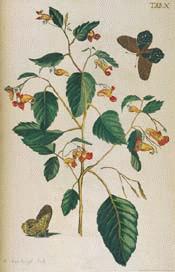
Botanical.com Home Page

|
Jewelweed
(Impatiens capensis Meerb.)
Click on graphic for larger image
|
Jewelweed
Botanical: Impatiens aurea (MUHL.), Impatiens biflora (WALT.)
Family: N.O. Geraniaceae
---Synonyms---Wild Balsam. Balsam-weed. Impatiens pallida. Pale-touch-me-not. Spottedtouch-me-not. Slipperweed. Silverweed. Wild Lady's Slipper. Speckled Jewels. Wild Celandine. Quick-in-the-hand.
---Part Used---Herb.
---Habitat---Members of the genus Impatiens are found widely distributed in the north temperate zone and in South Africa, but the majority are natives of the mountains of tropical Asia and Africa.
The flowers, purple, yellow, pink and white, sometimes a showy scarlet, are spurred and irregular in form and are borne in the leaf axils.
The name Impatiens is derived from the fact that the seed-pod, when ripe, discharges the seeds by the elastic separation and uncoiling of the valves.
Under the name of Jewelweed the herbage of Impatiens aurea and of I. biflora are largely employed in domestic practice and by homoeopaths and eclectics.
---Description---The plants are tall and branching, tender and delicate succulent annuals, with swollen joints, growing in lowlying, damp, rather rich soil, beside streams and in similar damp localities.
They are smooth and somewhat glaucous, the stems somewhat translucent, the foliage showing a brilliant silvery surface when immersed in water, which will not adhere to the surface.
The leaves are thin, ovate oval, more or less toothed, of a tender green colour.
The slipper-shaped, yellow flowers, in bloom from July to September, have long recurved tails, those of the first-named species being of a uniform pale-yellow, those of the second species, orange-yellow, crowded with dark spots, hence its common name of Spotted-touch-me-not. The oblong capsules of both species when ripe explode under the slightest disturbance, scattering the seeds widely. Most of the popular names refer to this peculiarity, others to the shape of the flowers.
---Medicinal Action and Uses---The herbs have an acrid, burning taste and act strongly as emetics, cathartics and diuretics, but are considered dangerous, their use having been termed 'wholly questionable.'
---Constituents---The chemical constituents are not known, though the leaves apparently contain tannin, which causes them to be employed as an outward application for piles, proving an excellent remedy, the freshly gathered plants being boiled in lard and an ointment made of them.
The fresh juice of the herb appears to relieve cutaneous irritation of various kinds, especially that due to Rhus poisoning.
A yellow dye has been made from the flowers.
[Top]
---Other Species---
The only species of Impatiens found wild in Europe is I. Noli-me-tangere, an annual, succulent herb about a foot high, with yellow flowers, in bloom in July and August, the lateral petals spotted with red (by cultivation, changing often to pale yellow and purplish).
This is our native 'Touch-me-not' or 'Quick-in-hand.' Although uncommon, it is to be found wild in moist mountainous districts in North Wales, Lancashire and Westmorland and occasionally in moist, shady places and by the banks of rivulets in other counties.
The plant will grow in cultivation, delighting in a moist soil and partially-shaded situations; the seeds being sown in autumn, soon after they are ripe. When once established, the plant will scatter its own seeds.
The whole plant is rather acrid, so that no animal except the goat will touch it.
It was formerly considered to have diuretic and vulnerary properties and was given to relieve haemorrhoids and strangury.
Boerhaave, the famous Dutch physician (1668-1738), considered it poisonous.
I. balsamina, the Common Balsam of gardens, a well-known annual, is a native of India, China and Japan. It is one of the showiest of summer and autumn flowers and of comparatively easy cultivation.
In the East, the natives use the prepared juice for dyeing their nails red.
I. Roylei, a tall, hardy, succulent annual, with rose-purple flowers, a Himalayan species, is common in England as a self-sown garden plant or garden escape.
I. Sultani, a handsome plant, with scarlet flowers, a native of Zanzibar, is easily grown in a greenhouse throughout the summer, but requires warmth in winter.
I. Cornuta, the 'Horned Balsam,' has long nectaries to its flowers, the spurs being three times as long as the corollas. In Ceylon it is called the 'Swallow-leaf.'
The whole plant is fragrant and in CochinChina, where it is a common garden weed, a decoction of the leaves is used as a hairwash, imparting a very sweet odour.
The 'Balsam Apple' is not related to the Impatiens, but is the fruit of Momordica balsamina.
[Top]
Common Name Index
A MODERN HERBAL Home Page
Bear in mind "A Modern Herbal" was written with the conventional wisdom of the early 1900's. This should be taken into account as some of the information may now be considered inaccurate, or not in accordance with modern medicine.
© Copyright Protected 1995-2025 Botanical.com
|

